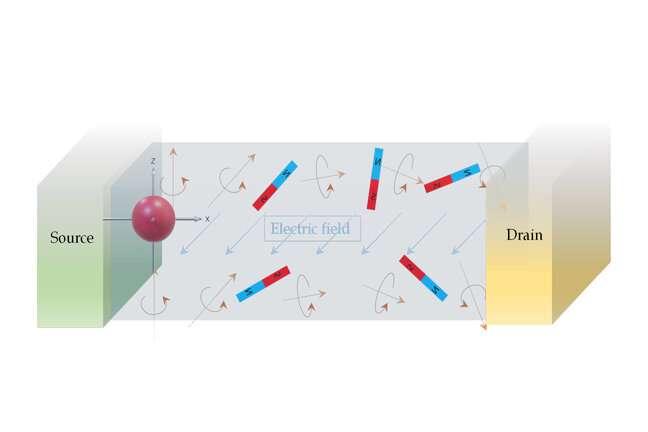Researchers learn to control electron spin at room temperature to make devices more efficient and faster

As our devices become smaller, faster, more energy efficient, and capable of holding larger amounts of data, spintronics may continue that trajectory. Whereas electronics is based on the flow of electrons, spintronics is based on the spin of electrons.
An electron has a spin degree of freedom, meaning that it not only holds a charge but also acts like a little magnet. In spintronics, a key task is to use an electric field to control electron spin and rotate the north pole of the magnet in any given direction.
The spintronic field effect transistor harnesses the so-called Rashba or Dresselhaus spin-orbit coupling effect, which suggests that one can control electron spin by electric field. Although the method holds promise for efficient and high-speed computing, certain challenges must be overcome before the technology reaches its true, miniature but powerful, and eco-friendly, potential.
For decades, scientists have been attempting to use electric fields to control spin at room temperature but achieving effective control has been elusive. In research recently published in Nature Photonics, a research team led by Jian Shi and Ravishankar Sundararaman of Rensselaer Polytechnic Institute and Yuan Ping of the University of California at Santa Cruz took a step forward in solving the dilemma.
“You want the Rashba or Dresselhaus magnetic field to be large to make the electron spin precess quickly,” said Dr. Shi, associate professor of materials science and engineering. “If it’s weak, the electron spin precesses slowly and it would take too much time to turn the spin transistor on or off. However, often a larger internal magnetic field, if not arranged well, leads to poor control of electron spin.”
The team demonstrated that a ferroelectric van der Waals layered perovskite crystal carrying unique crystal symmetry and strong spin-orbit coupling was a promising model material to understand the Rashba-Dresselhaus spin physics at room temperature. Its nonvolatile and reconfigurable spin-related room temperature optoelectronic properties may inspire the development of important design principles in enabling a room-temperature spin field effect transistor.
Simulations revealed that this material was particularly exciting, according to Dr. Sundararaman, associate professor of materials science and engineering. “The internal magnetic field is simultaneously large and perfectly distributed in a single direction, which allows the spins to rotate predictably and in perfect concert,” he said. “This is a key requirement to use spins for reliably transmitting information.”
“It’s a step forward toward the practical realization of a spintronic transistor,” Dr. Shi said.
When light and electrons spin together
Lifu Zhang et al, Room-temperature electrically switchable spin–valley coupling in a van der Waals ferroelectric halide perovskite with persistent spin helix, Nature Photonics (2022). DOI: 10.1038/s41566-022-01016-9
Citation:
Researchers learn to control electron spin at room temperature to make devices more efficient and faster (2022, July 14)
retrieved 14 July 2022
from https://phys.org/news/2022-07-electron-room-temperature-devices-efficient.html
This document is subject to copyright. Apart from any fair dealing for the purpose of private study or research, no
part may be reproduced without the written permission. The content is provided for information purposes only.
For all the latest Science News Click Here
For the latest news and updates, follow us on Google News.

